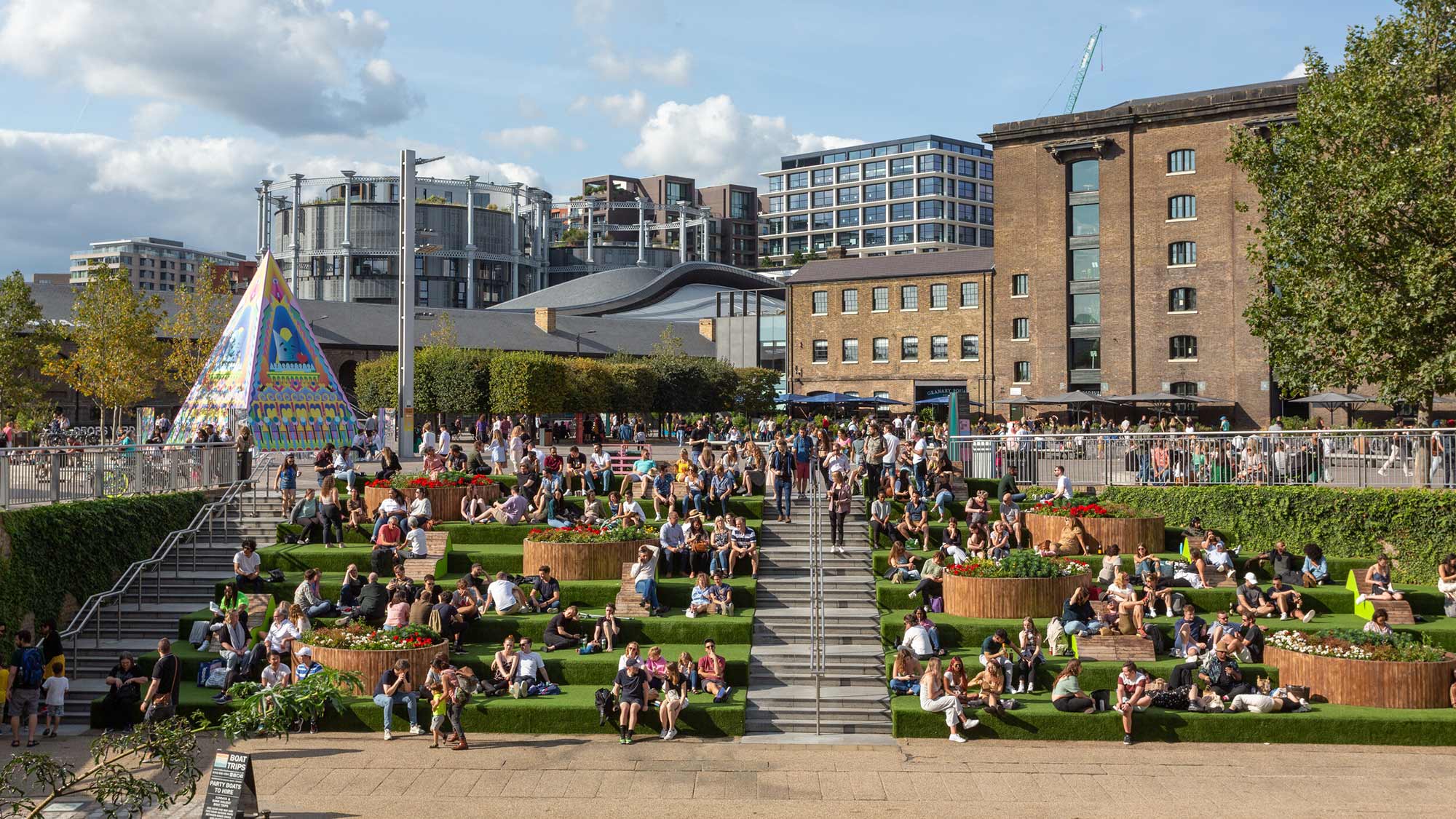It is over 15 years since high-speed rail services connected St Pancras in central London with mainland Europe. This is a story of engineering excellence and success but also of transformational city planning, urban renewal and economic growth. Whilst it would be easy in the UK to focus on the current challenges with HS2 as symbolic of our reluctance to embrace the benefits of high-speed rail, High Speed 1 (HS1) offers some real lessons and experiences of how to do things well.
The starting point
The original rail connection from London to the continent was from Waterloo, where services operated on existing track through south London before connecting with the new channel tunnel to France. The UK government and the national rail operator, British Rail, planned to build a high-speed link from the Channel Tunnel via Kent and south London. Arup pitched an alternative proposal: a route that would travel through the heart of Kent and arrive in London north of the Thames, running through Stratford in east London and into King’s Cross’s neighbouring station, St Pancras. This would catalyse the multi-billion-pound regeneration of Stratford in the heart of east London and the land around King’s Cross and St Pancras as well as the post-industrial communities of the southern Thames estuary and the disused chalk pits of Kent. It would provide not only a high-speed railway, but also a much-needed high-quality commuter service from Kent to London.
Adopting the Arup route
In 1991, Arup’s route for the Channel Tunnel Rail Link (CTRL) was given preferred status by the UK government. This came at a time when London’s Docklands and Canary Wharf were being radically redeveloped, and there was widespread enthusiasm for regeneration. Three years later, Arup became one of the founding partners of London & Continental Railways Ltd (LCR), which was set up to bid for the contract to build and operate the CTRL. The project was always conceived as a partnership between the public and private sector and although the structure of the project changed a number of times, it successfully captured a significant amount of private sector finance in the construction of the UK’s first new railway for over 100 years. The first section of HS1 opened in 2003 and the second section in 2007 with high-speed services operating from St Pancras in the heart of London to the centres of Paris and Brussels and now Amsterdam.
Integrated regeneration plans
Regeneration and economic development were vital components of the high-speed link from the start – from the derelict rail yards around St Pancras and King’s Cross stations, to economically deprived areas of east London and north Kent and the poorly connected rural areas beyond. The approach to regeneration was all-encompassing, involving new ways of working with local communities, new approaches to placemaking and funding development, and some of the most high-profile civic restoration projects in recent history.
The decision to integrate domestic high-speed services within HS1 was central to this broader perspective. The route entered London from the east through an area of north Kent that, by the 1990s, was blighted by high unemployment, largely due to the decline of heavy industries. This belt of communities had already been identified as a key focus of the Thames Gateway, a multi-billion-pound, government-backed plan for the massive redevelopment of both banks of the Thames east of London.
For London, the HS1 project came at an interesting time. Its population was growing for the first time since the post-war decline. A boom in financial services had led to the redevelopment of the Isle of Dogs as Canary Wharf, a second banking quarter in the east of the city. The centrepiece of this plan would be the redeveloped St Pancras, originally opened in 1868 and in a poor state of decline. This in turn would spearhead the regeneration of 27ha of contaminated railway land and car breakers’ yards immediately to the north of St Pancras and King’s Cross. By bringing an international dimension to the area, turning it into an accessible regional hub for European companies, the St Pancras redevelopment was the ideal springboard for this wider vision.
More than 15 years on from the completion of the line, what are the main lessons we can take away from the development of High Speed 1 and its stations from an urban planning and regeneration perspective?
1. More than a railway mindset from the outset
The shift in thinking from high-speed rail as ‘just a rail line’ to a major economic growth corridor changed how we think about the role of rail infrastructure in the UK and the catalytic impact it can have on economic growth and urban transformation. Arup introduced a ‘place-based’ approach to decision making for HS1 which won the argument with Government. This meant every decision that was taken from a route, station and design perspective was tested in terms of its ability to deliver the wider place-based outcomes. This is evident in the level of growth around stations at Kings Cross/St Pancras and Stratford where major new urban districts have been delivered which have created enormous economic value for the UK.
At King’s Cross – between 2010 and 2021 the number of firms based in the area doubled, jobs increased from 8,000 to just under 30,000 and new industries in the knowledge, creative and technology sectors have clustered and commercial values are some of the highest in central London. Investment in the public realm has created new public spaces and facilities for visitors and the surrounding community. This has been achieved through a partnership between the public and private sector but all enabled by making the right planning and design choices for the high-speed line from the outset. Without construction of the station at St Pancras and the reorientation of station entrances and passenger circulation to open up the railway lands to the rear, this scale of development would not have happened. This required an integrated approach to the design of the railway infrastructure with the master planning of surrounding neighbourhoods.
2. Governance and delivery structures for development and regeneration
The delivery of High Speed 1 required its own delivery structure reflecting the way in which the project was funded and delivered. This approach extended to consideration of development potential around the two stations at King’s Cross/St Pancras and Stratford where specific delivery structures were established in parallel to ensure the development of the surrounding area took place and in a way that was aligned with the aspirations of the local authorities and local communities. This required a different approach in each station location based on an assessment of the underlying economic conditions; the extent of market failure that existed; infrastructure needs/costs and the expectations of the local authorities and communities. At King’s Cross this included a development partnership with developer Argent to lead the development of publicly acquired land and at Stratford the establishment of a public sector-led development corporation to lead the development of the area including plans for the 2012 Olympic and Paralympic Games.
3. Plan for agility and change
Mega projects like HS1 are planned and delivered over many years, spanning multiple political cycles. For projects to remain politically supported, they need to be adaptive to change and responsive to changing political priorities and requirements. This project managed to achieve that by delivering across multiple outcomes and demonstrating a wide range of benefits that spanned political cycles. The scale of development at the two main stations has been delivered over a 15 to 20 year period, spanning different property cycles and the masterplan in each location has been adapted and flexed to allow for changes in market conditions, land uses and investor requirements. This has been achieved through a framework type approach where principles were agreed in advance with details developed over time based on local market conditions and public sector aspirations.
4. Connectivity drives accessibility which delivers positive change for communities
Whilst High Speed 1 radically improved international connectivity between London and Paris/Brussels, there was a specific objective to improve local connectivity along the corridor through the introduction of a separate domestic high-speed rail service operating on the same tracks. The purpose of this was to support regeneration in towns outside of London and increase the labour market catchment for the booming central London economy. This meant using the same physical infrastructure to deliver two completely separate rail services, each with its own set of objectives and economic outcomes.
5. A focus on the local as well as strategic
The scale of change associated with urban development around the two main stations of King’s Cross/St Pancras and Stratford was significant and an important objective was set from the outset to engage with the existing local community as plans were developed. In both locations, there was a bespoke approach to engagement, that matured over time and hugely influential in shaping the form of urban development in both places – land uses, public space, social infrastructure and connections to the surrounding area. As both locations were former railway sites, closed to the public there was a focus on integrating the new development with surrounding neighbourhoods – creating new connections and linkages and demonstrating the benefit of these to local people. This can be seen at both King’s Cross and Stratford where investment in bridges, streets, green spaces and public realm provides a seamless connection between old and new neighbourhoods. The mix of uses in both locations reflects the input from local communities with a strong balance of commercial and residential with social infrastructure, community, culture and the arts and education.
6. The challenge of demonstrating and capturing value
It is still difficult to quantify the transformative effect of major rail projects and a value framework needs to capture everything from land value, connectivity and economic growth to sustainability, resilience and placemaking. Overall, HS1 has been the catalyst for over £8bn of development. According to a 2020 report commissioned by HS1, the line supports more than £427m of economic benefits to the UK and continental Europe every year. It is expected to provide at least £10bn of regeneration benefits over the next 50 years. Demonstrating value at every stage of a long-term scheme is essential to retaining local support and investment, especially if the political or social climate changes. Phased delivery helps to balance long-term objectives with more immediate gains. This is now recognised as a critical part of any project business case and the consideration of how/when benefits are realised.
7. The station as a destination and value generator
Together with the redeveloped King’s Cross, St Pancras was at the forefront of a complete rethink of London’s large stations, turning them into places people actively choose to visit as opposed to ‘pass through’. According to the UK rail regulator, the Office of Rail and Road (ORR), by 2019, one in six of its 50 million annual customers were there purely to shop and use the bars and restaurants. This has helped to stitch St Pancras into the fabric of the wider community, bringing further economic and placemaking benefits for the surrounding area. Destination stations play a key role in bringing value to a local area through a mix of retail and leisure opportunities. This not only generates local employment, but also pulls visitors to the area. St Pancras has provided the template for other UK stations, such as Grand Central Station in Birmingham.
 ;
;
